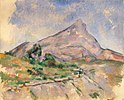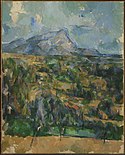Montagne Sainte-Victoire (målning)
Montagne Sainte-Victoire är en serie oljemålningar av den franske konstnären Paul Cézanne. Han målade ett 40-tal målningar av Montagne Sainte-Victoire från 1878 till sin död 1906. Berget är beläget i närheten av Aix-en-Provence i södra Frankrike, där konstnären föddes och levde större delen av sitt liv.
Cézanne var konstnären som övergav impressionismen för postimpressionismen och banade väg för modernismen. Denna utveckling är skönjbar i den långa serie målningar av Montagne Sainte-Victoire. I april 1878, när Cézanne åkte på den nyligen öppnade järnvägen mellan Aix och Marseille, beskrev han Montagne Sainte-Victoire som ett “beau motif” (vackert motiv)” i ett brev till Émile Zola. Järnvägsbron över Arcs floddal kan ses i flera målningar, bland annat den från 1882–1885 som är utställd på Metropolitan Museum of Art.
Ett urval Paul Cézanne-målningar av berget Sainte-Victoire
| Målning | Namn | År | Storlek | Plats | Land |
|---|---|---|---|---|---|
 | La Montagne Sainte-Victoire et le Viaduc de la vallée de l'Arc | 1882–1885 | 65,4 × 81,6 | Metropolitan Museum of Art, New York[1] | USA |
 | Plaine devant la montagne Sainte-Victoire | 1882–1885 | 58 × 72 | Pusjkinmuseet, Moskva[2] | Ryssland |
 | La Montagne Sainte-Victoire au grand pin | 1886-1887 | 60 x 72 | Phillips Collection, Washington[3] | USA |
 | La Montagne Sainte-Victoire | 1887 | 67 × 92 | Courtauld Institute of Art, London[4] | Storbritannien |
 | La Montagne Sainte-Victoire | 1890 | 65 × 95,2 | Musée d'Orsay, Paris[5] | Frankrike |
 | Montagne Sainte-Victoire | 1890–1895 | 55 × 65 | Scottish National Gallery, Edinburgh[6] | Storbritannien |
 | Mont Sainte-Victoire (La Montagne Sainte-Victoire) | 1892–1895 | 73 × 92 | Barnes Foundation, Philadelphia[7] | USA |
 | La Montagne Sainte-Victoire vue depuis Gardanne | 188 | 67 × 91 | National Gallery of Art, Washington[8] | USA |
 | La Montagne Sainte-Victoire vue de la carrière Bibemus | 1897 | 65 × 81 | Baltimore Museum of Art[9] | USA |
 | Route devant la Montagne Sainte-Victoire | 1896–1898 | 78 × 99 | Eremitaget, Sankt Petersburg[10] | Ryssland |
 | La Montagne Sainte-Victoire | 1897–1898 | 81 x 100,5 | Eremitaget, Sankt Petersburg[11] | Ryssland |
 | La Montagne Sainte-Victoire | 1902–1906 | 57 x 97 | Metropolitan Museum of Art, New York[12] | USA |
 | La Montagne Sainte-Victoire | 1902–1906 | 65 x 81 | Philadelphia Museum of Art[13] | USA |
 | La Montagne Sainte-Victoire | 1902–1906 | 63 × 83 | Kunsthaus Zürich[14] | Schweiz |
 | La Montagne Sainte-Victoire vue des Lauves | 1904–1906 | 84 x 65 | Princeton University Art Museum[15] | USA |
 | La Montagne Sainte-Victoire | 1904–1906 | 60 x 72 | Kunstmuseum Basel, Basel[16] | Schweiz |
Källor
- ^ Metropolitan Museum of Arts webbplats
- ^ Pusjkinmuseets wbbplats
- ^ Phillips Collections webbplats
- ^ ”Courtauld Institute of Arts webbplats”. Arkiverad från originalet den 22 juli 2019. https://web.archive.org/web/20190722130320/http://www.artandarchitecture.org.uk/images/gallery/9865405b.html. Läst 23 juli 2019.
- ^ ”Musée d'Orsays webbplats”. Arkiverad från originalet den 14 november 2019. https://web.archive.org/web/20191114170036/https://www.musee-orsay.fr/en/collections/index-of-works/notice.html?no_cache=1&zsz=5&lnum=17. Läst 23 juli 2019.
- ^ Scottish National Gallerys webbplats
- ^ Barnes Founations webbplats
- ^ National Gallery of Arts webbplats
- ^ Baltimore Museum of Arts webbplats
- ^ Eremitagets webbplats
- ^ Eremitagets webbplats
- ^ Metropolitan Museum of Arts webbplats
- ^ Philadelphia Museum of Arts webbplats
- ^ ”Kunsthaus Zürich”. Arkiverad från originalet den 12 juli 2020. https://web.archive.org/web/20200712105243/https://mplus.kunsthaus.ch/MpWeb-mpZuerichKunsthaus/v?mode=online&l=en#!m/Object/18/form/ObjCatalogueViewOnlineUser. Läst 23 juli 2019.
- ^ Princeton University Art Museums webbplats
- ^ Kunstmuseum Basels webbplats
Media som används på denna webbplats
Der Maler baut die Landschaft vor seinem immer wieder gewähltem Motiv, dem Hl. Siegesberg, aus lauter würfelig gehaltene Farbflecken auf und reduziert sie so auf deren grobe geometrische Grundform. Einzelne Umrisse verstärken den Bildgegenstand. Das Kolorit ausgewogen und nach Vorgabe aus der Natur übernommen. So gewinnt das Auge in dessen Addition dennoch einen natürlichen Eindruck - eine Impression.
Mont Sainte-Victoire with Large Pine (1886-1887) by Paul Cézanne The Phillips Collection
Cézanne first painted Mont Sainte-Victoire in 1870, beginning his decades-long fascination with the subject that ultimately yielded more than thirty paintings and watercolors of it. The peak played an important role in the ancient history of his native Aix-en-Provence. Its name refers to a Roman victory in 102 b.c. over Teutonic armies in the area. Cézanne created his later views of Sainte-Victoire, including this one, in his hillside studio at Les Lauves, where he was afforded a magnifi cent view of the soaring mountain from across the valley, with its farmland and distinctive olive and almond trees. -gallery label from the Princeton University Art Museum
The Plain with Mont Sainte Victoire, View from Valcros, oil on canvas, Pushkin Museum















